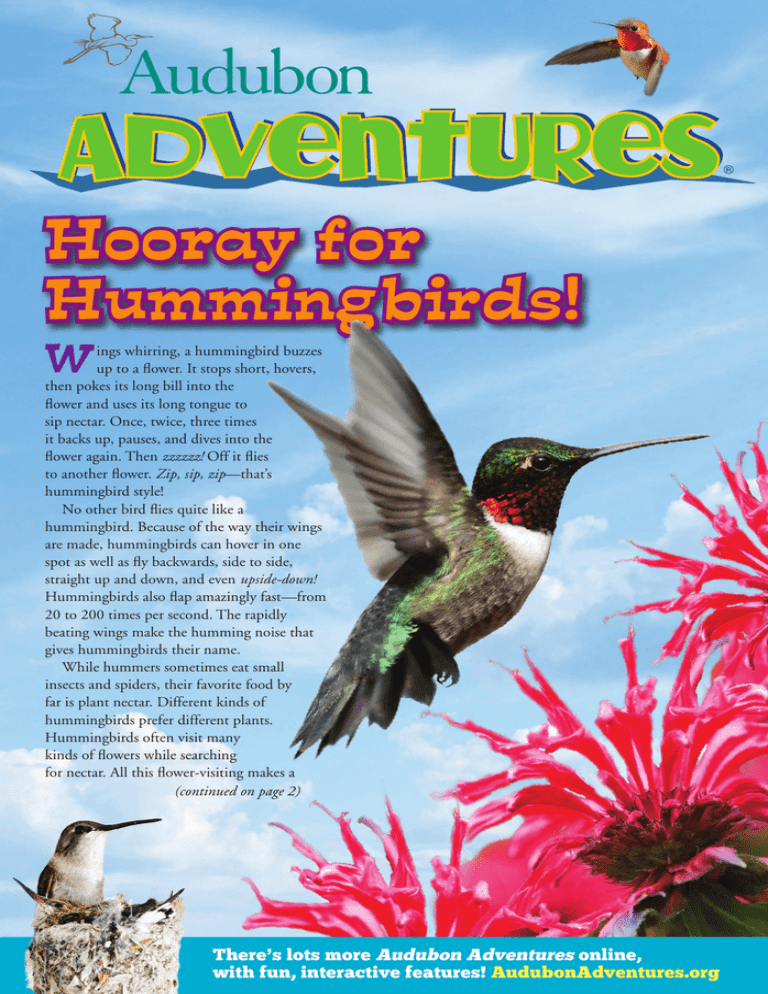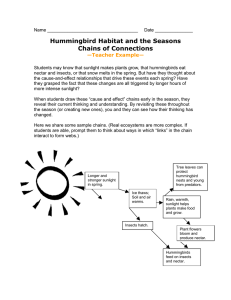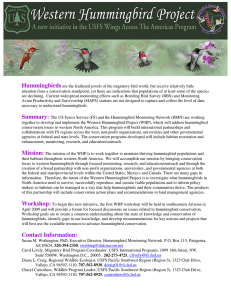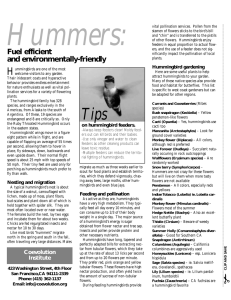
Hooray for
Hummingbirds!
W
ings whirring, a hummingbird buzzes
up to a flower. It stops short, hovers,
then pokes its long bill into the
flower and uses its long tongue to
sip nectar. Once, twice, three times
it backs up, pauses, and dives into the
flower again. Then zzzzzz! Off it flies
to another flower. Zip, sip, zip—that’s
hummingbird style!
No other bird flies quite like a
hummingbird. Because of the way their wings
are made, hummingbirds can hover in one
spot as well as fly backwards, side to side,
straight up and down, and even upside-down!
Hummingbirds also flap amazingly fast—from
20 to 200 times per second. The rapidly
beating wings make the humming noise that
gives hummingbirds their name.
While hummers sometimes eat small
insects and spiders, their favorite food by
far is plant nectar. Different kinds of
hummingbirds prefer different plants.
Hummingbirds often visit many
kinds of flowers while searching
for nectar. All this flower-visiting makes a
(continued on page 2)
There’s lots more Audubon Adventures online,
with fun, interactive features! AudubonAdventures.org
Hooray for Hummingbirds!
(continued from page 1)
hummingbird an excellent pollinator. Flowers need
pollen from other flowers to make seeds, but they can’t
visit other plants to swap pollen. Instead, some flowers
get the job done when their pollen sticks to a feeding
hummingbird’s feathers and bill. The hummer carries
this pollen to the next flower it visits.
Zzzzzz....
A
A female ruby-throated hummingbird gets
ready to sip some nectar.
It takes a lot of fuel to power a busy hummingbird
on an ordinary day. A hummingbird needs even more
energy when it’s migrating—traveling between the
place where it raises its young and the place where
it spends winter. Ruby-throated hummingbirds, for
example, double their weight before leaving their
winter home in Central America and migrating north.
Some of the other hummingbird species that migrate
to the United States and Canada are the rufous,
magnificent, and calliope hummingbirds.
n active hummingbird’s heart may thump more
than 1,200 times a minute. (Compare
that with your own heart rate, which is probably
somewhere between 60 and 100 beats per minute.) A
hummer’s body temperature is about 105°F. It burns
energy so fast, it must eat about half its own weight
in food each day. How can it possibly survive a cold
snap or a chilly night?
One survival strategy is to drop into a sleeplike
state called torpor when it gets too cold. In torpor, a
hummingbird’s body temperature and heart rate drop
to save energy. The heart of a hummer in torpor can
slow to as few as 50 beats per minute. Its temperature
may plunge to 60°F or even lower.
!
e
s
s
o
o
w
l
h
l
T
d
Fo
r
i
b
g
m
n
u
i
m
H
S
cientists are studying hummingbirds to find out
more about how they live and the migration paths
they follow. One thing they’re concerned about
is climate change. Along hummingbirds’
migratory routes, different plants bloom just
in time for the hungry travelers to grab a
meal. What if warmer spring temperatures
cause flowers to bloom earlier than
usual? The flowers could finish
blooming before the hummingbirds
arrive. No flowers would mean
no nectar. How would that
affect the migration
of hummingbirds, and even their survival?
Scientists are not the only ones fascinated by these
busy birds! Many people attract hummingbirds to their
yards and parks by planting flowers hummingbirds
like. Others hang up hummingbird feeders. And
they’re helping with scientific research, too. Across the
Americas, many people keep track of hummers they
see and report the results to scientists. You can too!
Become a citizen scientist by taking part in Audubon’s
“Hummingbirds at Home” project. Check out this
website to find out how you can track, report on,
and follow hummingbirds’ spring migration:
hummingbirdsathome.org
Size Extra-Extra
Small!
How small are hummingbirds?
Most are small. Some are VERY small!
The bee
hummingbird,
fo un d in Cuba, is th
e
world’s smallest bird
.
It measures 2 inch
es
from bill to tail.
d
m mingbir
Most hu
t
are abo u
species
es long.
3 1/2 inch
hroated
Ruby-tingbird
humm
Hummer
Humdingers!
A hummingbird zips at
about 30 miles per hour
in normal flight, but can
sometimes reach a top
speed of 60 miles per
hour in a dive.
Bee
ingbird
m
m
hu
hum
-matics!
MathT
3. The calliope
ry your math
skills using some
amazing hummingbird
facts. (Check your answers
hummingbird weighs
about 1/10th of an ounce.
How many calliope
hummingbirds
add up to
one ounce?
at the bottom of the page.)
1. A hummingbird
flicks its tongue up
to 13 times a second
to lick up nectar. How
many times can a
hummingbird flick its
tongue in 5 seconds?
4. A meal of nectar travels 2. The bee hummingbird is about
2 inches long, while the giant
hummingbird is about 8 inches long.
How many bee hummingbirds need
to line up in a row to
equal the length of a
giant hummingbird?
t hrough a hummingbird’s digestive
system in less than 20 minutes.
About how many minutes does it
take for a hummingbird
to digest three separate
meals?
The sword-billed
hummingbird of South
America has the longest
beak of any hummer. The
bill is up to 5 inches long
and shaped to probe into
a variety of extra-deep
flowers.
=
A female hummingbird
usually lays two eggs.
Some hummers lay eggs
that are about the size
of a jelly bean. Some
species' eggs are as
small as a pea.
5. If a hummingbird can flap its wings
up to 200 times a second, how
many times can it flap in
one minute?
Hummingbirds are tiny,
but they aren’t afraid of
bigger birds. A female
protecting her eggs will
even attack a hawk!
Math-hum-matics Answers 1. 65; 2. 4; 3. 10; 4. 60; 5. 12,000
They
Hummers
P
lants in a pollinator
Meanwhile, in the
garden offer nectar to
East, the Strawberry
hummingbirds as well as bees,
Plains Audubon Center
butterflies, and other pollinators.
in Holly Springs,
The Rio Salado Audubon Center
Mississippi, hosts a
in Phoenix, Arizona, started a
festival every September
pollinator garden in 2011. About
celebrating the migration
200 volunteers helped bring a barren
of ruby-throated
patch of ground to life. They planted
hummingbirds. Visitors
more than 500 plants! Since then,
have the chance to see
Harry the Hummingbird greets
Anna’s, Costa’s, and black-chinned
the amazing migrating
visitors to the Strawberry Plains
hummingbirds have all visited the
hummers up close, go on
Audubon Center's Hummingbird
garden. For hummers, the garden is a
nature walks and wagon
Migration Celebration.
place to stop, rest, and feed. For human
rides, and learn about
visitors, it’s a place to see flowers and birds as well as get other animals, including snakes, bats, bears, wolves,
ideas for creating their own pollinator gardens.
and spiders.
Be a Hummingbird
A
hummingbird may visit 2,000 flowers in one
day. Hummers are curious, so they’ll visit
all kinds of flowers to find nectar. But some flowers
have evolved specially to attract hummers. Next
time you’re where flowers are blooming, see if you
can find “hummingbird flowers” using these clues:
H
Buzz Online
A hummingbird
flower is typically
red—a color
hummers can see,
but insects can’t.
op on to these sites to learn more about
hummingbirds.
• Track, report on, and follow spring hummingbird
migration with Audubon’s “Hummingbirds at
Home”: hummingbirdsathome.org
• Set up a hummingbird feeder: athome.audubon.
org/hummingbirds-nectar-feeders-0
• Visit Journey North to track ruby-throated
hummingbird migration: learner.org/jnorth/humm/
• Watch a National Geographic video about hummers:
video.nationalgeographic.com/video/kids/animalspets-kids/birds-kids/hummingbird-kids/
It is tube-shaped—
just right for a
hummingbird’s
long bill.
Want to ID a
hummingbird?
Try being a hummingbird: Find a flower and
tap it once, counting to 10 before heading
off to the next one. How many can you
visit in 5 minutes?
Published by National Audubon Society
225 Varick St., 7th Floor, New York NY 10014
Audubon Adventures is a registered trademark of
National Audubon Society. All rights reserved ©2013
Subscriptions or customer service: Please call
Bonnie Godfrey at (800) 340-6546.
Learn more about Audubon Education:
education.audubon.org
Look for it here:
bit.ly/AudubonBirdID
Project Team: Elaine O’Sullivan, managing editor; Lorin
Driggs, principal editor; Christina Wilsdon, writer; Bluebird
Design Co./bluebirddesignco.com, design and spot graphics;
Sherrie York, photo researcher; Morgan Furze, editorial assistant;
Heidi DeVos, copy editor; Kathy Dale, Mozart DeDeaux,
Kelly Hunt, Geoff LeBaron, Bob Petty, Zach Slavin, Brenda
Townsend, Cathy Wise, scientific and educational reviewers.
We’re correlated! For correlations to the Common
Core Standards for English Language Arts and the
Next Generation Science Standards, go to:
education.audubon.org/state-standards-alignments
Photos: Cover: (top r) Tania Simpson; (all others)
Thinkstock. Page 2: (top l) Kelly Hunt/Photos by MK;
(btm r) Richard Pick; (btm bg) Thinkstock. Page 3:
(btm l) Dominic Sherony/Creative Commons; (r, t to
b) Thinkstock, Joseph C. Boone/Wikimedia, all others
Thinkstock. Page 4: (top inset) Kelly Hunt/Photos by
MK; (top ctr) Bruce Reid; (btm l bg) Thinkstock; (btm l)
Elizabeth Mitchell; (btm r) Bill Stripling.
Follow us on Facebook:
facebook.com/AudubonAdventures




